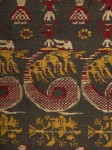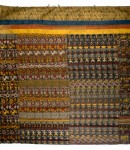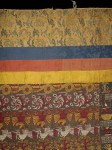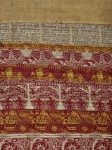
A 17th century devotional textile 30 feet long is going on display at the British Museum as the centerpiece of an exhibition about cultural history of the northeastern Indian state of Assam where it was made. Made around 1680, it’s a type of devotional textile known as the Vrindavani Vastra. This is example is the largest surviving Assamese devotional textile. It is composed of 12 strips of colored silk made using the lampas technique of weaving that were later stitched together to form a huge devotional wall hanging.
 According to the 10th-century Hindu scripture the Bhagavata Purana, Vrindavan, a town in Utter Pradesh, was the god Krishna’s childhood home and as such is considered a holy site to pilgrims today. Vrindavani Vastra means “the cloth of Vrindavan.” It is woven with scenes from Krishna’s youth in the Vrindavan forest. Krishna is depicted in repeated motifs fighting the bird demon Bakasura, dancing on the serpent Kaliya, swallowing the forest fire and other elements of Krishna worship that were significant to the 16th century Assamese scholar, mystic and saint Sankaradeva who wrote about them in his devotional dramas. A verse from one of Sankaradeva’s dramas is woven into the textile.
According to the 10th-century Hindu scripture the Bhagavata Purana, Vrindavan, a town in Utter Pradesh, was the god Krishna’s childhood home and as such is considered a holy site to pilgrims today. Vrindavani Vastra means “the cloth of Vrindavan.” It is woven with scenes from Krishna’s youth in the Vrindavan forest. Krishna is depicted in repeated motifs fighting the bird demon Bakasura, dancing on the serpent Kaliya, swallowing the forest fire and other elements of Krishna worship that were significant to the 16th century Assamese scholar, mystic and saint Sankaradeva who wrote about them in his devotional dramas. A verse from one of Sankaradeva’s dramas is woven into the textile.
 Assam is famous for its weaving, especially in silk and cotton. The lampas technique used to create this textile involved weaving on a a wooden draw-loom with two sets of warp and two sets of weft threads. It was famed for the vibrant and detailed textiles it could produce, and you can see in the Vrindavani Vastra what a wide range of figures, colors, designs, even text, could be made with this technique. Unfortunately despite its extensive use from the 16th through the 18th centuries, the technique is now lost.
Assam is famous for its weaving, especially in silk and cotton. The lampas technique used to create this textile involved weaving on a a wooden draw-loom with two sets of warp and two sets of weft threads. It was famed for the vibrant and detailed textiles it could produce, and you can see in the Vrindavani Vastra what a wide range of figures, colors, designs, even text, could be made with this technique. Unfortunately despite its extensive use from the 16th through the 18th centuries, the technique is now lost.
 The 12 strips of woven silk are each different but related. Experts believe they may have been used to wrap copies of the Bhagawad Purana or to decorate altars. At some point between their creation in the late 17th century and the early 20th century, the 12 strips made their way from Assam, which is just south of the eastern Himalayas, to Tibet where they were stitched together. Four horizontal strips of Chinese brocade and metal suspension loops were added to the top at that time so the now-huge textile could be hung on the wall of the monastery.
The 12 strips of woven silk are each different but related. Experts believe they may have been used to wrap copies of the Bhagawad Purana or to decorate altars. At some point between their creation in the late 17th century and the early 20th century, the 12 strips made their way from Assam, which is just south of the eastern Himalayas, to Tibet where they were stitched together. Four horizontal strips of Chinese brocade and metal suspension loops were added to the top at that time so the now-huge textile could be hung on the wall of the monastery.
 It was hanging on the wall of the Gobshi Temple near Gyantse in southern Tibet when Perceval Landon, correspondent for The Times came across it during the British expedition to Tibet, aka the Younghusband Expedition, in 1903-04. He acquired the piece and donated it to the British Museum in 1905.
It was hanging on the wall of the Gobshi Temple near Gyantse in southern Tibet when Perceval Landon, correspondent for The Times came across it during the British expedition to Tibet, aka the Younghusband Expedition, in 1903-04. He acquired the piece and donated it to the British Museum in 1905.
The textile has rarely been exhibited in its entirety. The new exhibition is the first to explore the vibrant cultural history of Assam.
In the exhibition, the Vrindavani Vastra will be displayed alongside other Assamese objects from the British Museum and several important loans, including another magnificent example of one of these Krishna textiles on loan from Chepstow Museum. This survives as the lining of a remarkable item of 18th-century Anglo-Indian costume. Manuscript leaves from the British Library, masks (the making and acquisition of which have been funded by the Luigi and Laura Dallapiccola Foundation) and modern textiles will help reveal this intriguing period in Indian history.
Krishna in the Garden of Assam: The Cultural Context of an Indian textile runs from January 21st through August 15th.